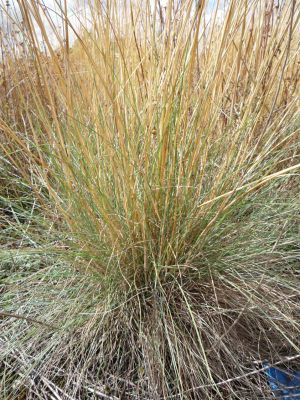Festuca roemeri
- Scientific Name: Festuca roemeri
- Family: Poaceae
- Common Names: Roemer's fescue
- Synonyms/Misapplications: Festuca idahoensis
- Codon: FESROE
Contents
Taxonomy
| Scientific classification | |
|---|---|
| Kingdom: | Plantae |
| Subkingdom: | Viridiplantae |
| Phylum: | Tracheophyta |
| Subphylum: | Spermatophytina |
| Class: | Magnoliopsida |
| Subclass: | Lilanae |
| Order: | Poales |
| Family: | Poaceae |
| Genus: | Festuca L. |
| Species: | Festuca roemeri (Pavlick) E.B. Alexeev |
Description
Tufted, perennial bunchgrass with mostly basal foliage[2] and narrow panicles, growing to 100 cm tall.[3] Culms hollow,[4] erect, glabrous,[5] light green to reddish.[2] Leaf sheaths closed for less than half their length,[5] collars glabrous, lower sheaths pale;[4] ligules 0.1-0.5 mm.[5] Panicles 5-20 cm long;[2] spikelets with 5-7 flowers;[3] point of disarticulation above glumes; glumes shorter than lemmas, lacking awnes, 1 and 3-nerved respectively;[4] lemmas 5-nerved[4] with 3-5 mm terminal awns;[5] paleas nearly equal in length to lemmas;[5] stamens 3.[4]
Bloom Period
May - July[6]
Distribution
British Columbia to California; mostly west of the Cascade crest in Washington.[6]
Habitat
Upland, dry to mesic rocky slopes and forest openings below 5000 ft. Prefers well-drained mineral soils, moderately acidic to slightly alkaline, fine to medium texture; does not tolerate flooding or soil saturation. Mid to late succession.[2]
Uses
Ecology and Wildlife
Roemer’s fescue is an important native grass for restoration of upland prairie and oak savanna within its natural range of western Oregon, western Washington, and northwest California. Typically found on steep, shallow, or highly mineral soils, it may also be useful for revegetation and erosion control where a slower establishing, fine textured native grass is desired, although Roemer’s fescue does not compete well with introduced grasses.[2]
Larval host to Mardon skipper (Polites mardon), a rare PNW butterfly.[7] Forage value and palatability for wildlife and livestock are unknown, but may be similar to Idaho fescue (F. idahoensis). Possible uses are low maintenance lawns or as a cover crop in vineyards and young orchards, although further evaluation is needed. Some populations and specimens have ornamental value, including those with fine textured, purple and red tinged stems or bluish foliage.[2]
Propagation
Propagate by seed, though seeds are not highly germinable. A seeding rate of 1 lb/ac results in about 12 seeds/sq. ft. Sown alone, recommended rates vary from 4 to 20 pure live seed (PLS) lbs/ac depending on goals. Fall seeding is generally preferred but not required. Rate of establishment from seed is moderately slow. Spring sown plants do not flower until the second full growing season.[2]
Native Plant Network Propagation Protocol
Photo Gallery
References
- ↑ Integrated Taxonomic Information System. Retrieved from https://www.itis.gov/servlet/SingleRpt/SingleRpt?search_topic=TSN&search_value=513556
- ↑ 2.0 2.1 2.2 2.3 2.4 2.5 2.6 USDA NRCS Plant Fact Sheet. Retrieved from https://plants.usda.gov/factsheet/pdf/fs_fero.pdf
- ↑ 3.0 3.1 Bowcutt, F., & Hamman, S. (2016). Vascular Plants of the South Sound Prairies. p. 125.
- ↑ 4.0 4.1 4.2 4.3 4.4 Hitchcock, C. L., Cronquist, A., Giblin, D., & Legler, B. et al. (2018). Flora of the Pacific Northwest: an illustrated manual. Seattle: University of Washington Press. pp. 795-796.
- ↑ 5.0 5.1 5.2 5.3 5.4 Flora of North America. Retrieved from http://dev.floranorthamerica.org/Festuca_roemeri
- ↑ 6.0 6.1 WTU Herbarium, Burke Museum, & University of Washington. Retrieved from https://biology.burke.washington.edu/herbarium/imagecollection/taxon.php?Taxon=Festuca%20roemeri
- ↑ Hatfield, R. et al. (2013). Management Plans for mardon skipper (Polites mardon ssp. klamathensis) sites on Lily Glen and Howard Prairie. USFS. Retrieved from https://www.fs.fed.us/r6/sfpnw/issssp/documents2/smp-iile-poma-lily-glen-howard-prairie-2013-03.pdf





